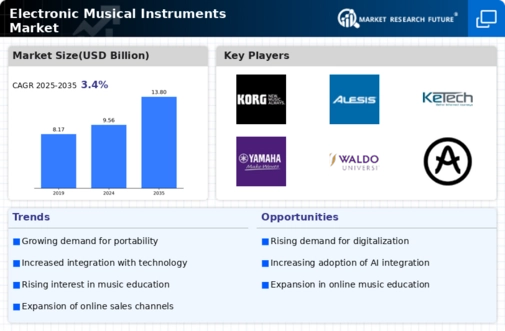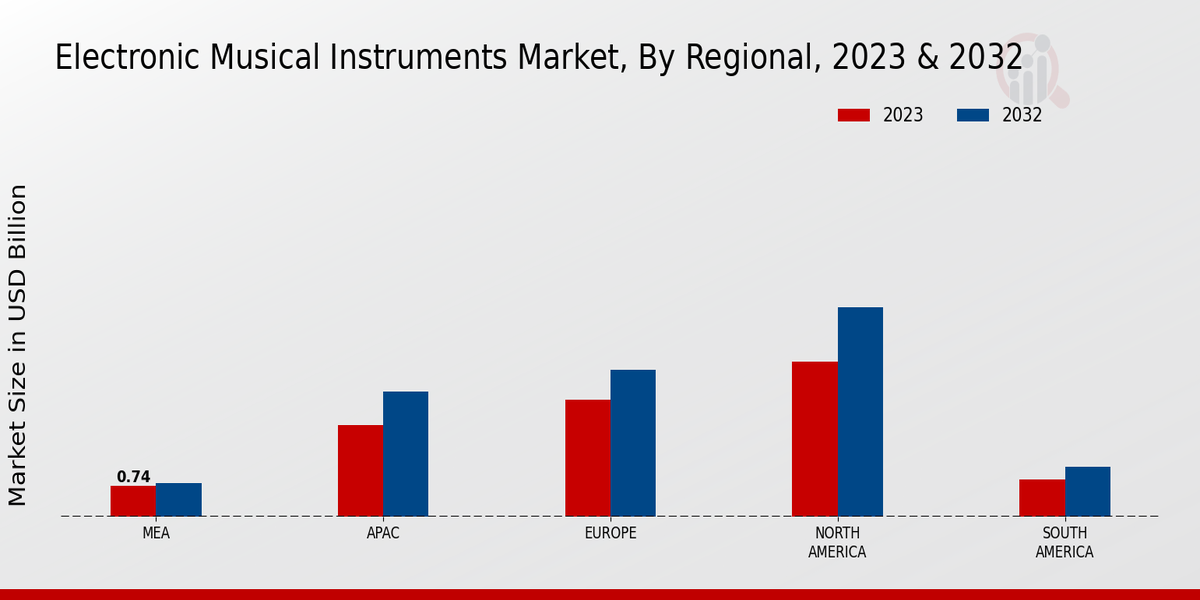Market Growth Projections
The Global Electronic Musical Instruments Market Industry is poised for steady growth, with projections indicating a compound annual growth rate (CAGR) of 3.41% from 2025 to 2035. This growth trajectory reflects the increasing integration of electronic instruments into various music genres and the expanding consumer base. As the market evolves, it is likely to witness innovations that cater to changing consumer preferences and technological advancements. The anticipated growth from 9.56 USD Billion in 2024 to 13.8 USD Billion by 2035 underscores the industry's resilience and adaptability. Stakeholders are encouraged to monitor these trends closely to capitalize on emerging opportunities.
Emerging Markets and Global Accessibility
Emerging markets present a significant opportunity for the Global Electronic Musical Instruments Market Industry. As economies develop and access to technology improves, more individuals in these regions are exploring music creation and performance. The affordability of electronic instruments makes them accessible to a broader audience, fostering a new wave of musicians. This trend is particularly evident in regions where traditional music practices are being complemented by modern electronic sounds. The potential for growth in these markets is substantial, as the industry adapts to meet the needs of diverse consumers. The ongoing globalization of music culture further enhances the appeal of electronic instruments across various demographics.
Growth of Live Music Events and Festivals
The resurgence of live music events and festivals significantly impacts the Global Electronic Musical Instruments Market Industry. As audiences return to live performances, there is a heightened demand for electronic instruments that cater to live settings. Musicians and DJs increasingly utilize electronic gear to enhance their performances, leading to a rise in sales of synthesizers, drum machines, and other electronic devices. This trend is expected to contribute to the market's growth, as live events create opportunities for musicians to showcase their skills and connect with audiences. The combination of live music experiences and electronic instruments is likely to foster a vibrant ecosystem within the industry.
Rising Demand for Digital Music Production
The Global Electronic Musical Instruments Market Industry experiences a notable surge in demand for digital music production tools. This trend is largely driven by the increasing number of aspiring musicians and producers who seek affordable and accessible electronic instruments. As of 2024, the market is valued at approximately 9.56 USD Billion, reflecting the growing interest in home studios and digital music creation. The proliferation of online platforms for music sharing and collaboration further fuels this demand, as individuals leverage electronic instruments to produce high-quality music from the comfort of their homes. This shift towards digital production is likely to continue, shaping the future landscape of the industry.
Technological Advancements in Instrument Design
Technological advancements play a pivotal role in the evolution of the Global Electronic Musical Instruments Market Industry. Innovations in software and hardware design enhance the functionality and versatility of electronic instruments, making them more appealing to both amateur and professional musicians. Features such as MIDI compatibility, advanced sound synthesis, and user-friendly interfaces are increasingly integrated into new models. These advancements not only improve the user experience but also expand the creative possibilities for musicians. As technology continues to evolve, the market is expected to grow, with projections indicating a value of 13.8 USD Billion by 2035, driven by ongoing innovation and consumer interest.
Increased Popularity of Music Education Programs
The Global Electronic Musical Instruments Market Industry benefits from the increasing popularity of music education programs. Schools and institutions are incorporating electronic instruments into their curricula, recognizing their relevance in contemporary music education. This trend encourages students to engage with technology and develop their musical skills using modern tools. As educational institutions invest in electronic instruments, the market sees a corresponding rise in demand. This focus on music education not only cultivates the next generation of musicians but also contributes to the overall growth of the industry. The integration of electronic instruments into educational settings is likely to create lasting impacts on future market dynamics.















